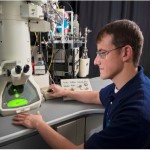 The ME-EM Graduate Seminar speaker on Thursday, September 11 at 4:00 in 103 EERC will be Dr. Kahlid Hattar from Sandia National Laboratory. The title of his presentation will be ‘In situ Nanoscale Testing to Validate and Elucidate Mechanism for Predictive Modeling’.
The ME-EM Graduate Seminar speaker on Thursday, September 11 at 4:00 in 103 EERC will be Dr. Kahlid Hattar from Sandia National Laboratory. The title of his presentation will be ‘In situ Nanoscale Testing to Validate and Elucidate Mechanism for Predictive Modeling’.
Topic: In situ Nanoscale Testing to Validate and Elucidate Mechanism for Predictive Modeling
Predicting performance margins of complex systems requires the development of multiscale physics based models that incorporate potential processing, microstructure, and property variations. To create the necessary set of models, a fundamental understanding of the physics governing the associated materials interplay and response in the expected environments of operation is essential. In situ transmission electron microscopy (TEM) experiments validated by welldesigned bulk tests provide an excellent tool to elucidate the underlying mechanisms that govern the properties of materials exposed to various environmental conditions of interest.
This presentation will demonstrate the breadth of in situ TEM research capabilities that are now available to the materials science community. These capabilities will be highlighted through a set of three experimental examples. In the first set, both the detrimental and beneficial effects of ion irradiation in face-centered cubic metal will be demonstrated.
The detrimental effect will be shown through a detailed comparison of displacement damage on the microstructure and mechanical properties of high purity Cu whereas the beneficial effect will be presented for Au electrical contacts. Recent advancements in in situ TEM stages permit studies in gas and liquid environments. To demonstrate the potential of these stages, recent work done at Sandia to understand the uptake and release of hydrogen in nanoporous Pd nanoparticles and the nanoscale mechanisms of corrosion in high purity Fe will be shown. Finally, the presentation will highlight the ability of in situ ion irradiation studies to investigate the structural evolution of advanced nanoscale detectors under controlled radiation environments.
This research was partially funded by the U.S. Department of Energy, Office of Science, Office of Basic Energy Sciences, Division of Materials Sciences and Engineering. Sandia National Laboratories is a multi-program laboratory managed and operated by Sandia Corporation, a wholly owned subsidiary of Lockheed Martin Corporation, for the U.S. Department of Energy’s National Nuclear Security Administration under contract DE-AC04-94AL85000.
Khalid Hattar is a Senior Member of the Technical Staff of Sandia National Laboratories. He
received a B.S. in Chemical Engineering from University of California, Santa Barbara in 2003, and a
Ph.D. in Materials Science and Engineering from University of Illinois, Urbana-Champaign in 2009.
He joined the Radiation-Solids Interaction group at Sandia in December 2008. He specializes in
determining the property-microstructure relationship
for a variety of structural, electrical, and optical
materials through in situ TEM in various extreme
environments.